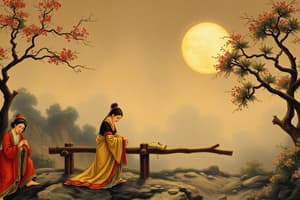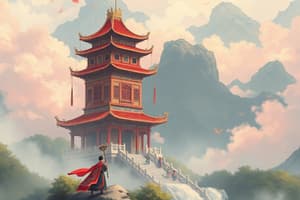Podcast
Questions and Answers
What were the primary reasons for China's cessation of overseas expeditions during the Ming Dynasty?
What were the primary reasons for China's cessation of overseas expeditions during the Ming Dynasty?
- A shortage of skilled sailors
- Desire for more direct warfare capabilities
- A belief that Chinese resources were sufficient (correct)
- Pressure from European nations
What lead to the rise of Fascism in Japan?
What lead to the rise of Fascism in Japan?
- Yuan dynasty
- Qing dynasty
- Meiji Restoration (correct)
- Ming dynasty
Which emperor succeeded Hong Wu in the Ming Dynasty?
Which emperor succeeded Hong Wu in the Ming Dynasty?
- Qianlong
- Zheng Ho
- Kangxi
- Yonglo (correct)
Who founded the Ming dynasty?
Who founded the Ming dynasty?
What was a significant impact of Zheng Ho's expeditions?
What was a significant impact of Zheng Ho's expeditions?
What policy did the Ming dynasty adopt after 1433?
What policy did the Ming dynasty adopt after 1433?
What principle did the design of the Forbidden City reflect?
What principle did the design of the Forbidden City reflect?
What was the primary reason for the decline of the Ming dynasty in the early 1600s?
What was the primary reason for the decline of the Ming dynasty in the early 1600s?
What consequence did the regulated trade practices in China have during the Ming Dynasty?
What consequence did the regulated trade practices in China have during the Ming Dynasty?
Which emperor ruled the Qing dynasty from 1661 to 1722?
Which emperor ruled the Qing dynasty from 1661 to 1722?
Who invaded China in 1644, leading to the formation of the Qing Dynasty?
Who invaded China in 1644, leading to the formation of the Qing Dynasty?
What practice did the British refuse when trading with China?
What practice did the British refuse when trading with China?
Which term describes the practice required by traders to show respect to the Chinese rulers?
Which term describes the practice required by traders to show respect to the Chinese rulers?
What was the primary socioeconomic status of merchants in Ming and Qing China?
What was the primary socioeconomic status of merchants in Ming and Qing China?
What did Yong Lo sponsor during the Ming dynasty?
What did Yong Lo sponsor during the Ming dynasty?
What significant diplomatic event occurred involving King George III and China?
What significant diplomatic event occurred involving King George III and China?
Which dynasty was formed after the Manchus invaded and assimilated into the Ming dynasty?
Which dynasty was formed after the Manchus invaded and assimilated into the Ming dynasty?
Which hall is known as the Hall of Great Ceremony in the Forbidden City?
Which hall is known as the Hall of Great Ceremony in the Forbidden City?
Which two emperors are associated with the peak of prosperity in the Qing Dynasty?
Which two emperors are associated with the peak of prosperity in the Qing Dynasty?
During which time period did the Qing dynasty reach its peak?
During which time period did the Qing dynasty reach its peak?
What was one of the impacts of the British smuggling opioids into China?
What was one of the impacts of the British smuggling opioids into China?
What was the primary role of the Tokugawa Shogun in Japan?
What was the primary role of the Tokugawa Shogun in Japan?
Which economic condition characterized the Tokugawa period in Japan?
Which economic condition characterized the Tokugawa period in Japan?
What led to the flight of peasants to Old Edo during the Tokugawa period?
What led to the flight of peasants to Old Edo during the Tokugawa period?
Which code defined the conduct of samurais during the Tokugawa period?
Which code defined the conduct of samurais during the Tokugawa period?
What was a significant result of Japan's isolation under the Tokugawa Shogunate?
What was a significant result of Japan's isolation under the Tokugawa Shogunate?
What role did Zen Buddhism play in Tokugawa Japan?
What role did Zen Buddhism play in Tokugawa Japan?
How did the Tokugawa Shogunate impact social hierarchy in Japan?
How did the Tokugawa Shogunate impact social hierarchy in Japan?
What was the primary reason for the lack of foreign influence during the Tokugawa era?
What was the primary reason for the lack of foreign influence during the Tokugawa era?
Which figure was instrumental in unifying Japan and establishing the Tokugawa Shogunate?
Which figure was instrumental in unifying Japan and establishing the Tokugawa Shogunate?
Flashcards
Qianlong's Opium stance
Qianlong's Opium stance
Qianlong, a Chinese emperor, rejected British resources.
Tokugawa Shogunate
Tokugawa Shogunate
A period (1467-1658) of fighting in Japan among powerful land-owning lords.
Japanese Feudalism
Japanese Feudalism
Japanese social hierarchy with King, land owners, and warriors.
Tokugawa Ieyasu
Tokugawa Ieyasu
Signup and view all the flashcards
Edo Period Capital
Edo Period Capital
Signup and view all the flashcards
Japanese Social Hierarchy
Japanese Social Hierarchy
Signup and view all the flashcards
Bushido
Bushido
Signup and view all the flashcards
Zen Buddhism
Zen Buddhism
Signup and view all the flashcards
Commodore Perry
Commodore Perry
Signup and view all the flashcards
Meiji Restoration
Meiji Restoration
Signup and view all the flashcards
Ming Dynasty
Ming Dynasty
Signup and view all the flashcards
Zheng He's Expeditions
Zheng He's Expeditions
Signup and view all the flashcards
Chinese Isolationism
Chinese Isolationism
Signup and view all the flashcards
Kowtow
Kowtow
Signup and view all the flashcards
Qing Dynasty
Qing Dynasty
Signup and view all the flashcards
Yongle Emperor
Yongle Emperor
Signup and view all the flashcards
Kangxi Emperor
Kangxi Emperor
Signup and view all the flashcards
Qianlong Emperor
Qianlong Emperor
Signup and view all the flashcards
Trade Regulation (China)
Trade Regulation (China)
Signup and view all the flashcards
Ming Dynasty Decline
Ming Dynasty Decline
Signup and view all the flashcards
Ming Dynasty Founder
Ming Dynasty Founder
Signup and view all the flashcards
Ming Dynasty Values
Ming Dynasty Values
Signup and view all the flashcards
Qing Dynasty Formation
Qing Dynasty Formation
Signup and view all the flashcards
Kowtow Ceremony
Kowtow Ceremony
Signup and view all the flashcards
Qing Dynasty's Height
Qing Dynasty's Height
Signup and view all the flashcards
Yuan Dynasty
Yuan Dynasty
Signup and view all the flashcards
Study Notes
Ming and Qing China
- The Mongols conquered China and established the Yuan Dynasty.
- The Chinese overthrew the Mongols and created the Ming Dynasty.
- Hongwu, a peasant, founded the Ming Dynasty.
- Yongle, Hongwu's son, sponsored Zheng He's voyages.
- Zheng He's voyages explored the Indian Ocean region using large Chinese ships (junks).
- Yongle halted the voyages due to perceived cost.
- China practiced isolationism in overseas trade from the mid-1400s to the 1500s.
- Vasco da Gama used warfare and fighting in trade.
- China established key port cities where only Europeans could trade and established high taxes.
- China's trade practices led to a booming black market for luxury goods.
- Merchants held higher socioeconomic status than peasants, but lower than the ruling class in Confucian society.
- The Ming Dynasty weakened due to corruption, poor leadership, and heavy taxation.
- The Manchus invaded and established the Qing Dynasty in 1644.
- The Qing Dynasty marked a period of great prosperity for China with a large population.
- Kangxi ruled the Qing Dynasty from 1661 to 1722.
- Qianlong ruled from 1735 to 1795 and is considered a high point in the Qing Dynasty.
Tokugawa Japan
- Japan experienced a period of civil war from 1467 to 1658.
- Feudal lords (daimyo) and samurai controlled Japan.
- Japanese society had a strict social hierarchy with the emperor at the top.
- Similar to the European feudal system, daimyo held land and power.
- Samurai warriors served the daimyo and were loyal to them.
- Japan's feudal system was similar to the medieval European system of knights.
- The Tokugawa Shogunate established a unified, centralized rule in Japan in 1603.
- Tokugawa Ieyasu declared himself shogun to restore order.
- Japan's economy remained primarily agricultural but was stable.
- Peasants were heavily taxed, but Japan was relatively isolated from the outside world.
- The development of the kabuki theater was a sign of the changing societal dynamics.
- King George III sent an expedition to trade with China, but was refused entry due to the kowtow ceremony.
- Britain smuggled opium into China to gain trade access, and this event eventually led to the Opium Wars.
- This forced China to open to trade.
Zen Buddhism
- Zen Buddhism, a form of Buddhism, emphasizes meditation and self-discipline.
- Zen emphasized the importance of the body and mind.
- Zen Buddhism was dominant in Japan during this period.
Studying That Suits You
Use AI to generate personalized quizzes and flashcards to suit your learning preferences.




